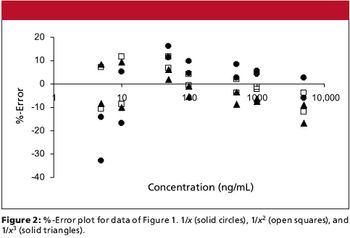
In this installment, the subject of LPME is reviewed, with emphasis on the use of hollow fibers.

In this installment, the subject of LPME is reviewed, with emphasis on the use of hollow fibers.

The procedure involves a rapid and efficient pretreatment with SampliQ QuEChERS kits. The homogenized liver sample was initially extracted in a buffered aqueous/1% acetic acid acetonitrile system with an extraction and partitioning step after the addition of salts. Finally, the sample was cleaned up using dispersive solid-phase extraction (dispersive-SPE). The final extracts were analysed by the sensitive and selective determination of all compounds in a single run using LC–ESI-MS–MS operating in positive ion multiple reaction monitoring (MRM) mode. Sulphapyridine was selected as the internal standard. The accuracy of the method, expressed as recovery, was between 53 and 93%. The precision, expressed as RSD, was between 2.1 and 16.8%. The established 5 ng/g limits of quantification (LOQ) were much lower than the respective maximum residue limit (MRL) for sulphonamide in animal food products (20–100 ng/g).

The procedure involves a rapid and efficient pretreatment by SampliQ QuEChERS kits. The homogenized liver sample was initially extracted in a buffered aqueous, 5% formic acid acetonitrile system. An extraction and partitioning step was performed after the addition of salts. Clean-up was done using dispersive solid-phase extraction (dispersive-SPE). The final extracts allowed determination of all compounds in a single run using LC–ESI-MS–MS operating in positive ion multiple reaction monitoring (MRM) mode. Norfloxacin was selected as the internal standard. The accuracy of the method, expressed as recovery, was between 62 and 113%. The precision, expressed as RSD, was between 2.2 and 13.4%. The established limit of quantification (LOQ) was 5 ng/g and is significantly lower than the respective maximum residue limit (MRL) for quinolones in food producing animals.

The QuEChERS method for pesticide analysis was first introduced by USDA scientists in 2003. The EN method 15662:2007 is a European variation to the QuEChERS method. The method uses acetonitrile extraction, followed by the salting out of water from the sample using anhydrous magnesium sulphate (MgSO4, NaCl and buffering citrate salts to induce liquid–liquid partitioning.

The QuEChERS method for pesticide analysis was first introduced by USDA scientists in 2003.1 The EN method 15662:2007 is a European variation to the QuEChERS method.2,3

Based on the QuEChERS AOAC Official Method 2007.01, 16 pesticides were used for evaluating the performance of the Agilent's AOAC buffered extraction and SampliQ QuEChERS dispersive SPE kits for general fruits and vegetables.

Based on the QuEChERS AOAC Official Method 2007.01, sixteen pesticides were used for evaluating the performance of the Agilent's AOAC Buffered Extraction and SampliQ QuEChERS Dispersive SPE kits for General Fruits and Vegetables. Apple was selected as the fruit matrix. The pesticides are from the "representative pesticides" list (1). A method working well for these representative pesticides should work equally well for the other pesticides that are routinely monitored in multi-class, multi-residue methods. The compounds are from nine different pesticide classes: including acidic, basic, neutral, base-sensitive, and acid-labile pesticides. The selected pesticides are suitable for LC–MS-MS analysis. The MRLs of these pesticides have been set at 10 ng/g or higher (2–4).

Published: March 2nd 2010 | Updated:

Published: March 2nd 2010 | Updated:

Published: August 1st 2010 | Updated:

Published: December 2nd 2009 | Updated:

Published: October 2nd 2009 | Updated:

Published: July 2nd 2009 | Updated: